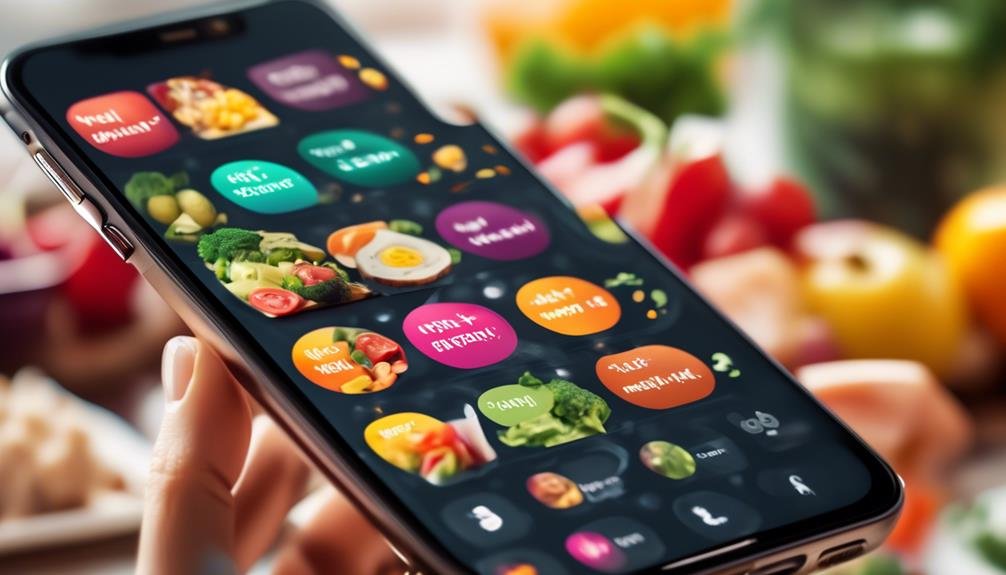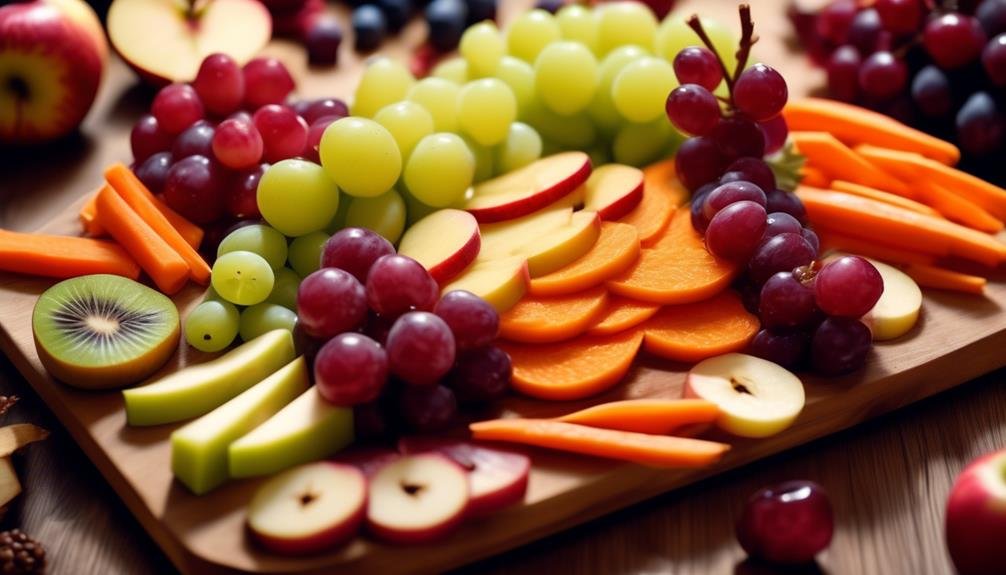"Cherishing Little Steps - A Haven for Baby and Family Journeys"
Nutrition Apps for Parents
Imagine having a personal nutritionist right at your fingertips, guiding you through the labyrinth of healthy eating for your little ones. Nutrition apps for parents serve as a virtual compass, steering you towards nourishing choices, while simplifying the daunting task of meal planning.
But with so many options available, how do you choose the right app for your family's needs? In this discussion, we will explore the benefits of using nutrition apps, the top features to look for, as well as essential nutrients for growing kids and practical tips for encouraging healthy eating habits.
So, whether you're a seasoned parent looking to revamp your mealtime routine or a new parent seeking guidance, this discussion will equip you with the knowledge to make informed choices for your family's nutrition journey.
Key Takeaways
- Nutrition apps can help parents track food intake and monitor nutritional needs for their children.
- These apps offer personalized meal planning and recipe suggestions to ensure a balanced diet.
- Nutrition apps provide educational resources and tips on healthy eating habits, promoting overall health and preventing childhood obesity.
- By instilling good eating habits in children from an early age, nutrition apps can contribute to their long-term health and well-being.
Benefits of Using Nutrition Apps
Using nutrition apps can provide numerous benefits for parents looking to improve their family's eating habits and ensure their children receive proper nutrition. These apps play a crucial role in promoting overall health and preventing childhood obesity.
One of the key benefits of using nutrition apps is the ability to track your family's food intake and monitor their nutritional needs. These apps offer features that allow you to easily log meals and snacks, helping you keep track of calorie intake and nutrient content. By having a clear understanding of what your family is consuming, you can make informed decisions about their diet and ensure they're getting the necessary nutrients.
Additionally, nutrition apps often provide meal planning and recipe suggestions based on specific dietary requirements. This not only saves time but also ensures that your family is eating a balanced and nutritious diet. You can explore various meal options and recipes that are tailored to your family's preferences and dietary needs, making healthy eating more enjoyable for everyone.
Moreover, these apps often provide educational resources and tips on healthy eating habits. They can help you identify the nutritional value of different foods, understand portion sizes, and make healthier food choices. By incorporating these tools into your daily routine, you can instill good eating habits in your children from an early age, setting them up for a lifetime of healthy choices.
Top Features to Look for in a Nutrition App
To ensure you find the most effective nutrition app for your family's needs, it's important to consider the top features that can enhance your experience and support your goals for healthy eating.
One key feature to look for in a nutrition app is meal tracking. This feature allows you to easily record and monitor your daily food intake, helping you stay accountable and make informed choices. With meal tracking, you can keep track of the calories, macronutrients, and micronutrients consumed, giving you a clear picture of your overall nutrition.
Another important feature to consider is personalized recommendations. A good nutrition app should be able to provide customized meal plans and suggestions based on your specific dietary needs and preferences. Whether you have dietary restrictions, allergies, or simply want to follow a certain eating pattern, such as vegetarian or gluten-free, personalized recommendations can help you navigate the world of healthy eating with ease.
Furthermore, it's beneficial to choose a nutrition app that offers a wide variety of food options and a comprehensive database. This ensures that you have access to a vast range of foods, including brand-name products and meals from popular restaurants. A robust database allows you to accurately track your food intake and make informed decisions about your meals.
How to Choose the Right Nutrition App for Your Family

When selecting a nutrition app for your family, it's important to consider their specific dietary needs and preferences. With so many options available, it can be overwhelming to find the right one. To help you make an informed decision, here are four key factors to consider:
- Meal tracking: Look for an app that allows you to easily track your family's meals and snacks. This feature will help you monitor their nutritional intake and identify areas for improvement.
- Personalized recommendations: Find an app that offers personalized recommendations based on your family's unique needs. This could include suggestions for healthier alternatives, portion sizes, and meal ideas.
- User-friendly interface: Opt for an app that's intuitive and easy to navigate. A clutter-free design and simple interface will make it more enjoyable for you and your family to use on a daily basis.
- Integration with other devices: Consider whether the app can sync with other devices, such as fitness trackers or smart kitchen appliances. This integration can provide a more comprehensive picture of your family's overall health and wellness.
Essential Nutrients for Growing Kids
Essential nutrients play a crucial role in supporting the growth and development of children. As a parent, it's essential to ensure that your growing child receives the necessary nutrients for optimal health. For infants, breast milk or formula provides the essential nutrients they need, including proteins, fats, carbohydrates, vitamins, and minerals.
As your baby grows, you can start introducing solid foods to their diet to provide them with a wider range of nutrients. When introducing solid foods to your baby, it's important to start with simple, single-ingredient foods. This allows you to identify any potential allergies or sensitivities. Good options to begin with include pureed fruits and vegetables, such as apples, pears, sweet potatoes, and carrots.
As your baby becomes more comfortable with these foods, you can gradually introduce a wider variety, including proteins like mashed beans or finely chopped, well-cooked meats. To ensure your child is getting a balanced diet, include a variety of foods from different food groups. This will help provide the necessary nutrients for their growth and development.
Some essential nutrients to focus on include iron, calcium, vitamin D, and omega-3 fatty acids. Iron-rich foods like fortified cereals, meat, poultry, and beans help support brain development and prevent anemia. Calcium-rich foods like yogurt, cheese, and leafy greens contribute to strong bones and teeth. Vitamin D, which aids in calcium absorption, can be obtained through sunlight exposure and fortified foods like milk. Omega-3 fatty acids, found in fish like salmon and mackerel, promote brain and eye development.
Meal Planning Made Easy With Nutrition Apps

Nutrition apps can be a helpful tool for parents looking to simplify meal planning and ensure their children are receiving the necessary nutrients for optimal health. With the hectic schedules and endless responsibilities that come with parenting, it can be challenging to plan and prepare nutritious meals for your little ones. However, these meal planning apps can make the process easier and more efficient.
Here are four ways nutrition apps can assist you in meal planning:
- Personalized meal plans: These apps offer customizable meal plans tailored to your child's age, dietary preferences, and any specific nutritional needs they may have.
- Recipe suggestions: Nutrition apps provide a wide range of healthy and kid-friendly recipes to inspire your meal planning. They often include step-by-step instructions and nutritional information for each recipe.
- Grocery shopping guide: Many of these apps come with built-in grocery lists that make it easy to plan your shopping trips. They can suggest the best ingredients for each recipe and help you stay organized while navigating the supermarket aisles.
- Nutritional analysis: These apps can analyze the nutritional value of your planned meals, ensuring that your child is getting all the essential nutrients they need. They can track their daily intake of vitamins, minerals, and other important nutrients.
Tracking Your Child's Nutritional Intake With Apps
To effectively track your child's nutritional intake, utilizing nutrition apps can provide valuable insights into their dietary habits and help ensure they are receiving the necessary nutrients for optimal growth and development. These apps can be a convenient and efficient way to keep track of what your child is eating and make informed decisions about their meals.
One of the key features of nutrition apps is meal tracking, which allows you to record and monitor your child's food intake throughout the day. With just a few taps on your smartphone, you can easily input the foods they consume, including portion sizes and any specific nutritional information. This helps you keep track of their overall calorie intake, as well as the amount of essential nutrients they are getting, such as protein, carbohydrates, and vitamins.
In addition to meal tracking, nutrition apps often provide tools for portion control. These apps can help you determine appropriate portion sizes for your child based on their age, weight, and activity level. By having a clear understanding of portion sizes, you can ensure that your child is eating the right amount of food for their nutritional needs.
To give you a better idea of how nutrition apps can assist you in tracking your child's nutritional intake, here is a simple table showcasing the features of three popular apps:
| App Name | Meal Tracking | Portion Control |
|---|---|---|
| App A | Yes | Yes |
| App B | Yes | Yes |
| App C | Yes | Yes |
Healthy Snack Ideas for Kids

When it comes to providing your children with nutritious and satisfying snacks, there are plenty of options to choose from that will keep them energized and satisfied throughout the day.
Here are some creative snack ideas that aren't only kid-friendly but also packed with essential nutrients:
- Fruit and Yogurt Parfait: Layer low-fat yogurt with fresh fruits like berries, sliced bananas, and granola for a delicious and healthy treat.
- Veggie Sticks with Hummus: Slice up colorful veggies such as carrots, cucumbers, and bell peppers and serve them with a side of creamy hummus for a crunchy and nutritious snack.
- Cheese and Whole Wheat Crackers: Pair slices of low-fat cheese with whole wheat crackers for a protein-rich snack that will keep your kids satisfied between meals.
- Homemade Trail Mix: Combine a variety of nuts, dried fruits, and whole-grain cereal for a customizable and portable snack that's rich in fiber and healthy fats.
These snack ideas not only provide essential nutrients like vitamins, minerals, and fiber but also help to keep your children full and satisfied. By incorporating these creative and nutritious snacks into your child's diet, you can ensure they're getting the fuel they need to thrive throughout the day.
Fun and Interactive Recipes for Picky Eaters
For picky eaters, finding fun and interactive recipes can be a great way to encourage them to try new foods and develop a healthier relationship with food. When children are engaged in the cooking process, they're more likely to be open to trying new flavors and textures. By involving them in the preparation of meals, you can create a positive and enjoyable experience around food.
One creative way to introduce new foods is by making food art. Encourage your child to create fun and colorful designs using fruits, vegetables, and other healthy ingredients. This not only makes the meal visually appealing but also encourages your child to explore different foods in a playful manner.
Another idea is to turn mealtime into a game. Create a menu with various healthy options and let your child choose what they want to eat. You can even set up a 'restaurant' at home, complete with menus, tablecloth, and special utensils. This can make the dining experience more exciting and encourage your child to try new foods.
Incorporating fun and engaging activities for picky eaters is a great way to make mealtimes enjoyable and encourage them to expand their food preferences. By being creative in the kitchen and making mealtime a fun experience, you can help your child develop a positive relationship with food and cultivate healthy eating habits.
Tips for Encouraging Healthy Eating Habits in Children

Encouraging healthy eating habits in children can be achieved through consistent modeling of nutritious food choices and creating a positive food environment at home. As a parent, you play a crucial role in shaping your child's eating habits and establishing a foundation for a lifetime of good nutrition. Here are some practical tips to help you in this journey:
- Involve Children in Meal Preparation: Engage your child in meal planning, grocery shopping, and cooking. This not only teaches them about different foods but also empowers them to make healthier choices. Let them choose a recipe or assist in chopping vegetables. This hands-on experience can make eating more enjoyable for them.
- Role of Portion Sizes: Teach your child about portion sizes and the importance of listening to their body's hunger and fullness cues. Encourage them to eat until they're satisfied, not until they're overly full. This helps them develop a healthy relationship with food and prevents overeating.
- Create a Positive Food Environment: Make mealtimes pleasant and stress-free. Sit down together as a family, turn off screens, and focus on enjoying each other's company. Avoid labeling foods as 'good' or 'bad' and instead emphasize the importance of balance and moderation.
- Be a Role Model: Children learn by observing their parents' behaviors. Show them your own commitment to healthy eating by choosing nutritious foods and enjoying them. Be mindful of your own eating habits and try to make positive changes together as a family.
Understanding Food Labels With Nutrition Apps
To further enhance your understanding of nutrition and make informed food choices, nutrition apps can serve as valuable tools. They can help you navigate through the complex world of food label regulations and decode nutrition information. With these apps, you can easily access detailed information about the ingredients, nutritional value, and allergens of various food products.
Food label regulations vary from country to country, making it challenging to understand the information provided on food packaging. However, nutrition apps can simplify this process by providing clear explanations and breaking down the information into easily understandable terms. They can help you identify key nutrients, such as calories, fat, carbohydrates, and protein, and compare them to your daily recommended intake.
Decoding nutrition information is essential for making healthy choices for you and your family. Nutrition apps can help you identify hidden sugars, unhealthy fats, and artificial additives in the food you buy. They can also provide alternatives or suggest healthier options based on your dietary preferences and requirements.
Managing Food Allergies With Nutrition Apps

Nutrition apps can be invaluable tools in managing food allergies, providing you with essential information and resources to ensure the safety of you and your family. When it comes to food allergy management, personalized meal plans can make a world of difference. These plans take into account your specific dietary restrictions and help you navigate through the complex world of food allergies.
Here are four ways nutrition apps can assist you in managing food allergies:
- Allergen identification: These apps allow you to easily identify potential allergens in various food products. Simply scan the barcode or search for the specific item, and the app will provide you with detailed information about its ingredients and potential allergens.
- Recipe customization: With personalized meal plans, you can customize recipes to suit your specific dietary needs. These apps provide you with alternative ingredient options, allowing you to modify recipes without compromising on taste or nutrition.
- Shopping assistance: Nutrition apps can help you create shopping lists tailored to your food allergies. They can also suggest allergen-free alternatives for ingredients you need, making grocery shopping a breeze.
- Emergency preparedness: In case of an allergic reaction, these apps can provide you with quick access to emergency contact information, allergy action plans, and nearby hospitals or clinics.
Budget-Friendly Meal Ideas for Families
When it comes to feeding your family on a budget, there are plenty of delicious and nutritious meal ideas to choose from. By adopting a few budget-friendly shopping and meal prepping tips, you can provide wholesome meals for your family without breaking the bank.
One way to save money on groceries is by planning your meals in advance. Sit down and create a weekly or monthly meal plan, taking into account the ingredients you already have and what's on sale at the store. This will help you avoid impulse purchases and reduce food waste. Additionally, buying in bulk and using coupons can significantly cut down on your grocery bill.
To further stretch your budget, consider incorporating more plant-based meals into your menu. Plant-based proteins like beans, lentils, and tofu are not only affordable but also packed with nutrients. Try adding a Meatless Monday to your weekly routine and experiment with vegetarian recipes.
Another cost-saving strategy is to make use of leftovers. Transforming last night's dinner into a new meal the next day can save you time and money. For example, leftover chicken can be turned into a delicious chicken salad or used as a topping for a homemade pizza.
Here is a table with some budget-friendly meal ideas to inspire you:
| Meal Idea | Ingredients |
|---|---|
| Vegetable stir-fry | Mixed vegetables, tofu, soy sauce |
| Bean and vegetable soup | Beans, vegetables, broth, herbs |
| Pasta with marinara sauce | Pasta, canned tomatoes, garlic, onions |
Frequently Asked Questions
Are Nutrition Apps Only Helpful for Parents With Picky Eaters?
Nutrition apps can be helpful for all parents, not just those with picky eaters. They provide guidance and resources to help parents encourage healthy eating habits in their children.
Can Nutrition Apps Provide Personalized Meal Plans for Children With Specific Dietary Needs?
Nutrition apps can definitely provide personalized meal plans for children with specific dietary needs. They take into account factors like allergies, intolerances, and nutritional requirements to create tailored plans that ensure your child gets the right nutrients.
Do Nutrition Apps Track Both Macronutrients and Micronutrients?
Yes, nutrition apps can track both macronutrients and micronutrients. They provide a comprehensive analysis of the nutrients in your food, ensuring you have a balanced diet and meet your nutritional needs.
How Can Nutrition Apps Help Parents Manage Food Allergies in Their Children?
Want to manage your child's food allergies? Nutrition apps can help! These handy tools provide information on allergens in foods, offer allergy-friendly recipes, and assist with meal planning to ensure your child's safety and health.
Can Nutrition Apps Help Parents Stay Within a Specific Budget While Planning Meals for Their Family?
Yes, nutrition apps can help you stay within a specific budget while planning meals for your family. They provide meal planning features, grocery list generators, and price comparison tools to make budgeting easier.
Conclusion
In conclusion, nutrition apps for parents offer a convenient and effective way to ensure your family is eating healthy.
By providing essential nutrients, assisting with meal planning, and helping you understand food labels, these apps make it easier to encourage healthy eating habits in children.
Additionally, they can help manage food allergies and provide budget-friendly meal ideas for families.
With the right nutrition app, you can take control of your family's nutrition and promote a healthier lifestyle.


